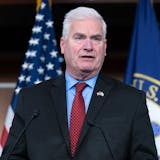Minnesota's achievement gaps are a chronic crisis, and our state's inability to fix our schools is problematic ("Math and reading scores drop," Aug. 30).
Too many of our schools are failing to meet kids' academic needs, leaving them unprepared for college and careers. For example, by fourth grade, one-quarter or fewer indigenous, black and Latinx Minneapolis students are reading at grade level, compared with nearly 80% of white students. Minnesota has the lowest high school graduation rates for black and Latinx students in the country, second-lowest for indigenous students.
Through our work partnering with schools and investing in communities that are underserved, we encounter many schools that also struggle to meet kids' social emotional and cultural needs. Coupled with low expectations for kids of color and academic programs that fall short, unprecedented numbers of families have been in search of better school options ("More leave Mpls. public schools," front page, Aug. 29).
Outside of their lived experiences, families are confronted with lacking, inaccessible information on how schools fare.
Education Commissioner Mary Cathryn Ricker's new "The State of Our Students" report, too, falls short (tinyurl.com/ricker-report). Despite years of new investments in education, all-day kindergarten and expanded pre-K options, the needle isn't moving. The report also follows old patterns of focusing the blame on kids, especially those of color and/or from a low-income background. How about the schools' performance? What will be different this school year for kids of color? We cannot let another year go by.
But I also appreciate that Ricker values a more holistic set of school quality indicators. As a community, we need to fully embrace the Minnesota Comprehensive Assessments. They're aligned to state standards, and they're the only "check engine" light that we have to know whether students are mastering grade-level material (from it, we know that only a fraction of Minneapolis' kids of color are reading at grade level). But the MCAs are not the only indicator of a high-quality school.
I urge Ricker to include families, especially those underserved, in building measurable academic and nonacademic indicators that are actually accessible for families — no matter their ethnic background, socioeconomic status or native language.
Many families struggle with housing and income inequality, especially those of color or indigenous. Gaps are not exclusive to K-12. However, parents believe schools are fundamentally responsible for children's learning. The Star Tribune and Minnesota Comeback's Minneapolis School Finder both point to schools that are "beating the odds," so we know there are schools that educate all students and post strong results — no matter a child's background.



